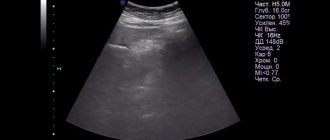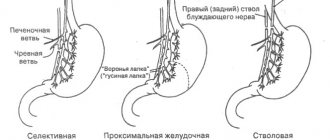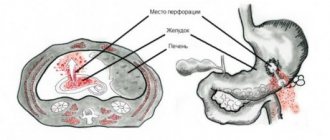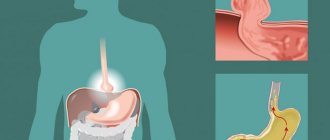What is appendicitis?
Appendicitis is a disease characterized by inflammation of the wall of the appendix (the vermiform appendix of the cecum). It is located in the lower right part of the abdomen, which is also called the iliac region. In the adult body, the appendix has no function, so its removal (appendectomy) does not harm human health.
Most often, the appendix becomes inflamed in people aged 10 to 30 years.
When complications of acute appendicitis may occur
Acute inflammation of the appendix in humans occurs in several stages. First, catarrhal changes occur in the walls of the processes, usually lasting for 48 hours. At this time, there are almost never serious complications.
After the catarrhal stage, destructive changes follow; appendicitis from catarrhal can become phlegmonous, and then gangrenous. This stage lasts from two to five days. During this time, purulent melting of the walls of the appendix occurs and a number of dangerous complications may develop, such as perforation followed by peritonitis, infiltration and a number of other pathologies.
If there is no surgical treatment during this period, then other complications of acute appendicitis arise, which can cause death. In the late period of appendicitis, which occurs on the fifth day from the onset of inflammation of the appendix, diffuse peritonitis develops, and an appendiceal abscess and pylephlebitis are often detected.
Various complications of acute appendicitis are possible after surgery. The causes of postoperative complications are associated with untimely operation, late diagnosis of acute appendicitis, and surgeon errors. More often, pathological disorders after surgery develop in older people with a history of chronic diseases. Some complications may also be caused by patients’ failure to comply with doctor’s recommendations in the postoperative period.
Thus, complications in patients with acute appendicitis can be divided into two groups. These are those that develop in the preoperative period and those that develop after surgery. Treatment of complications depends on their type, the patient’s condition and always requires a very careful attitude of the surgeon.
Main symptoms
Before moving directly to what complications may occur after acute appendicitis, let’s look at what symptoms will help you suspect the presence of inflammation in order to promptly seek medical help.
If chronic inflammation of the appendix may not manifest itself for a long time and not cause inconvenience to the patient, then acute appendicitis has clear symptoms:
- sharp, severe pain in the upper abdomen (epigastric region), which gradually descends down and to the right (into the iliac region);
- increased pain when turning to the right side, when coughing, walking;
- tension in the muscles of the anterior abdominal wall, which occurs due to pain that the patient experiences when moving the abdominal muscles;
- possible accumulation of gases in the intestines, constipation;
- low-grade fever (up to 37.5 °C).
Intraoperative consequences of appendectomy
According to studies, intraoperative abnormalities occur in 1-4% of patients with acute appendicitis. The reason is tactical or technical errors. All intraoperative consequences are divided into the following groups:
Related article: Botox can penetrate the central nervous system and cause harm
| Consequences group | Consequences |
| Associated with pneumoperitoneum |
|
| Laparoscopic access |
|
| Specific complications of appendectomy |
|
| Electrosurgical (always pose a particular danger to the patient and are associated with errors by the operating surgeon or medical staff) |
|
Classification of appendicitis
Perhaps for ordinary people it does not matter much what kind of inflammation of the appendix is observed in his case. However, it is very important for the surgeon to know the type of appendicitis, because depending on this, the prognosis for the further course of the disease and the likelihood of complications can be determined. This also determines surgical tactics.
The following types of appendicitis are distinguished:
- catarrhal or simple - the most common form;
- surface;
- phlegmonous - purulent inflammation of the appendix;
- gangrenous - with the development of necrosis of the process;
- perforated - with destruction of the appendix and penetration of intestinal contents into the abdominal cavity.
It is the phlegmonous and gangrenous types that are the most unfavorable from the point of view of the development of complications. These types of appendicitis require the greatest attention from the surgeon and immediate surgical intervention. And the perforated appearance, in fact, is a complication after gangrenous appendicitis.
Types of complications
Complications after appendicitis can be divided into two large groups.
The first includes complications of the inflammation itself, which often results from untimely seeking of medical help. These are complications such as:
- appendicular infiltrate - the formation of a conglomerate from intestinal loops, mesentery and other abdominal organs around the appendix;
- abscesses in the abdominal cavity (in the pelvis, between the intestinal loops, under the diaphragm);
- peritonitis - inflammation of the peritoneum;
- pylephlebitis is an inflammation of the portal vein (the vessel that carries blood to the liver), as well as its branches.
Complications after appendicitis surgery most often develop in the wound and abdominal cavity. However, there may be complications in the respiratory organs, genitourinary and cardiovascular systems.
Treatment protocol for patients with acute appendicitis
Classification:
Morphological form: catarrhal, phlegmonous, gangrenous.
Complications: appendiceal infiltrate, perforation, appendiceal abscess, peritonitis (limited, widespread), retroperitoneal phlegmon, pylephlebitis.
Diagnostics.
In the emergency department, after examination by a surgeon, within 1 hour from the time of admission, the patient should undergo the following tests: general clinical blood test, blood biochemistry, coagulogram, general urinalysis, blood group and Rh factor, ECG, chest x-ray and abdominal cavity, ultrasound examination of the abdominal cavity.
In cases of unclear clinical picture, computed tomography of the abdominal cavity and pelvis is performed. All female patients are subject to examination by a gynecologist. If necessary, consultations are carried out with a urologist and a therapist.
If the clinical picture is unclear and there are no obvious signs of other acute surgical pathology, dynamic observation is indicated for 12 hours with an assessment of clinical and laboratory instrumental data over time.
If an unclear clinical picture persists after a 12-hour observation and it is impossible to exclude acute appendicitis, as well as for the purpose of differential diagnosis with other acute diseases of the abdominal and pelvic organs, diagnostic laparoscopy is indicated as the final stage of diagnosis, which, if necessary, can be transformed into laparoscopic appendectomy.
In any doubtful cases, if it is impossible to exclude acute appendicitis, the choice of treatment is decided in favor of surgery. If a diagnosis of acute appendicitis is established, surgical treatment should be started within 2 hours from the moment of diagnosis.
Anesthesia.
The priority option is combined endotracheal anesthesia.
Surgical tactics.
The priority is to perform video laparoscopic appendectomy.
Contraindications to videolaparoscopic appendectomy are: severe cardiovascular and respiratory failure, widespread peritonitis, severe adhesions in the abdominal cavity, severe scarring on the anterior abdominal wall due to previous operations. If there are contraindications to videolaparoscopic appendectomy and there are no indications for performing a median laparotomy (see below), appendectomy from the Volkovich-Dyakonov approach is indicated.
During laparoscopic appendectomy, the mesentery of the appendix is coagulated in parts using Ligasure bipolar electrocoagulation and divided. The base of the process is ligated with three ligatures to form Reder nodes. Between two distal ligatures, the appendix is intersected, the stump is treated with iodine or alcohol, then, depending on the diameter, the appendix is removed from the abdominal cavity through a trocar or in an endocontainer through a trocar incision.
If there are inflammatory changes in the area of the base of the appendix, its stump, after preliminary ligation with a ligature, is immersed in a purse-string and (or) “Z”-shaped suture. If it is impossible to reliably cover the stump of the appendix with a purse-string and (or) “Z”-shaped suture, resection of the dome of the cecum with the stump of the appendix using Eshelon or EndoGia devices is recommended. The operation always ends with at least one drainage tube left in the pelvic cavity.
If there is a visual picture of catarrhal appendicitis and the clinical picture of the disease does not correspond to morphological changes, an additional inspection of the ileum (at least 1 meter) and uterine appendages for the pathology of these organs is indicated.
With secondary (superficial) appendicitis, the main (primary) pathological process is sanitized; appendectomy is performed only in the presence of a destructive form of inflammation of the appendix (phlegmonous, gangrenous).
The removed vermiform appendix is sent for histological examination. The effusion and contents of abscesses are sent for bacteriological examination to identify the microflora and its sensitivity to antibiotics.
In cases where widespread fibrinous (purulent-fibrinous) peritonitis is detected during surgery, midline laparotomy and appendectomy are indicated (see section “Peritonitis”).
The use of antibiotics in acute appendicitis.
- Antibiotic prophylaxis.
Antibiotic prophylaxis is indicated in all cases of surgery for acute appendicitis.
Antibiotic prophylaxis is carried out with generation cephalosporins. The first dose of the drug (2 g) is administered intravenously 30 minutes before the start of surgery.
In case of acute catarrhal appendicitis, 2 g of the drug is re-administered after 12 hours.
For destructive forms of appendicitis, antibacterial therapy is carried out in the postoperative period.
- Antibacterial therapy.
In case of acute phlegmonous appendicitis, therapy is carried out with generation cephalosporins in a dosage of 2 g x 2 times a day - 5 days.
In acute gangrenous appendicitis, with complications such as perforation, abscess, peritonitis, a combination of third-generation cephalosparins (4 g/day), aminoglycosides (amikacin 7.5 mg/kg - 2 times a day), metronidazole (2 g/day) is indicated. .
Surgical tactics for appendiceal infiltration.
The clinical and instrumental picture of appendiceal infiltrate without signs of abscess formation is a contraindication to surgery - hospitalization, conservative therapy (antibacterial, local hypothermia), computed tomography, ultrasound in dynamics are indicated in order to exclude its abscess formation. After resorption of the infiltrate, patients should be examined (after 3-6 months) and, if necessary, operated on as planned. In cases of abscessation of the appendiceal infiltrate, confirmed by ultrasound or computed tomography, opening and drainage of the abscess under ultrasound control or extraperitoneal access according to Pirogov is indicated.
If laparoscopy reveals a dense appendiceal infiltrate, drainage of the abdominal cavity is performed. If a dense appendicular infiltrate is detected during a traditional operation, appendectomy is unacceptable - the area of infiltration should be delimited by 2-3 gauze swabs removed through the wound. In the future, these patients are given antibacterial therapy until the infiltrate is resorption.
Appendiceal infiltrate
When answering the question of what complications there may be after appendicitis, first of all it is necessary to highlight the formation of appendiceal infiltrate. It is a group of abdominal organs and tissues fused together that limit the appendix from the rest of the abdominal cavity. As a rule, this complication develops a few days after the onset of the disease.
Symptoms of complications after appendicitis, specifically appendicular infiltrate, are characterized by a decrease in the intensity of pain in the lower abdomen. It becomes less sharp, but more dull, has no clear localization, and only increases slightly when walking.
When palpating the abdominal cavity, you can feel a fuzzy formation characterized by pain. Further, the infiltrate thickens, the contours become more blurred, and the pain disappears.
The infiltrate can resolve within one and a half to two weeks, however, it can also fester with the formation of an abscess. When suppuration occurs, the patient's condition sharply worsens, fever appears, the abdomen becomes painful on palpation, and the muscles of the anterior abdominal wall are tense.
Appendiceal abscess
A purulent, prognostically unfavorable complication after appendicitis is the formation of an abscess of the appendix. But abscesses can form not only directly in the appendix, but also in other places in the abdominal cavity. This occurs when the peritoneal effusion encystes and prevents the development of widespread peritonitis. Often this picture occurs as a complication after phlegmonous appendicitis.
To diagnose this complication and search for abscesses in the abdominal cavity, it is recommended to use ultrasound and computed tomography. If an abscess formed as a complication after appendicitis in women, its pelvic localization is typical. Then its presence can be determined using a vaginal examination.
Above is a CT scan showing the formation of an abscess in the anterior abdominal wall.
Indications for use
What you can't and can't eat after appendicitis constipation after appendicitis surgery diet
Laparoscopic appendicitis surgery is performed if a classic abdominal appendectomy cannot be performed due to the patient's poor health. This method of removing the inflamed appendix is practiced for acute and chronic processes.
Indications for minimally invasive appendectomy:
- Mucocele (cyst-shaped expansion of the appendix).
- Carcinoid tumors.
- Benign tumor neoplasms.
- The patient's desire to avoid the rough long scar that remains after abdominal removal of the appendix.
- Pathologies that increase the risk of purulent complications after classical surgery. These include abnormalities in the functioning of the endocrine system (diabetes mellitus, obesity).
- The patient is young. Due to the low invasiveness of the operation, adhesions do not develop.
- Inability to confirm or exclude inflammation in the appendix.
Laparoscopic removal of appendicitis is performed in young women of childbearing age when there is a suspicion of an inflammatory process in the abdominal cavity, which cannot be differentiated from gynecological pathologies. Unlike standard abdominal surgery, the laparoscopic access method does not cause adhesions, which cause infertility.
Contraindications
Removal of appendicitis by laparoscopic method is contraindicated if:
- low blood clotting;
- pathologies of the heart muscle and blood vessels;
- liver and kidney diseases;
- advanced peritonitis;
- increased density of purulent masses concentrated inside the inflamed appendix;
- accumulation of gases in the appendix;
- adhesive processes.
Removal of the appendix by laparoscopic method is not performed in women in the last trimester of pregnancy. A relative contraindication to surgery is the patient’s advanced age.
Advantages
Compared to the classic method of surgical removal of an inflamed appendix, the laparoscopic appendectomy technique has several advantages:
- low trauma to internal organs;
- absence of large scars on the skin;
- rehabilitation is faster;
- low risk of complications after appendicitis;
- the ability to determine immediately whether another abdominal operation will be required.
If the operation was performed correctly, the prognosis is always favorable. The patient recovers quickly and, subject to the doctor’s recommendations, soon leaves the hospital.
Surgery to remove appendicitis, video:
Purulent peritonitis and pylephlebitis
These two types of complications occur least frequently, but are most unfavorable for the patient. Peritonitis as a complication after appendicitis occurs only in 1% of cases. But this pathology is the main cause of death in patients with appendicitis.
The rarest condition with inflammation of the appendix is pylephlebitis (septic inflammation of the portal vein). As a rule, it is a complication after appendectomy, however, it can develop even before surgery. It is characterized by a sharp deterioration in the patient’s general condition, high fever, and a sharply swollen abdomen. If the veins that pass directly into the liver tissue are damaged, jaundice occurs, the liver becomes enlarged, and liver failure develops. The most likely outcome of this condition is the death of the patient.
Complications arising from the surgical wound
And now we will talk about complications after appendicitis surgery. The first group of complications are those that are limited to the surgical wound. Inflammatory infiltrates and suppuration develop most often. As a rule, they occur 2-3 days after removal of the appendix, while pain in the wound that has already subsided returns again, body temperature rises, and general condition worsens.
On the wound, when the bandage is removed, redness and swelling of the skin are visualized, and the threads of the postoperative sutures cut into the skin. On palpation, sharp pain is observed and a dense infiltrate is palpable.
After a few days, if you do not intervene in time and prescribe treatment, the infiltrate may fester. Then its boundaries become less clear; upon palpation, one can detect a symptom of fluctuation, which characterizes the presence of purulent fluid. If the abscess is not opened and drained, it can become chronic. Then the patient's condition becomes worse and worse. He loses weight, becomes exhausted, his appetite is reduced, and constipation occurs. After a certain time, the purulent process from the subcutaneous tissue spreads to the skin and opens on its own. This is accompanied by the leakage of pus and relief of the patient’s condition.
In addition to the most common complications listed above after removal of appendicitis, the following pathological conditions may occur in the postoperative wound:
- hematoma;
- bleeding;
- divergence of edges.
The most common complications after appendicitis
The reasons for the appearance of consequences as a result of removal of the appendix may be violations during the operation or medical errors. Factors such as the patient ignoring doctors’ recommendations, non-compliance with hygiene and regimen, and late referral to specialists cannot be excluded. The following symptoms indicate the possibility of consequences of the operation:
- severe abdominal pain;
- increased body temperature;
- indigestion;
- nausea, vomiting;
- suppuration, compaction of the surgical suture.
After removal of appendicitis, diseases of the abdominal organs, cardiovascular, and respiratory systems may develop. The following complications of appendectomy are often encountered:
- adhesive disease;
- bleeding;
- divergence of wound edges;
- intestinal obstruction;
- pylephlebitis - purulent inflammation of the portal, mesenteric vein;
- pulmonary embolism;
- fistulas in the intestines;
- hematomas;
- abscess;
- hernia;
- peritonitis;
- pneumonia;
- urinary retention;
- acute cystitis;
- nephritis.
Articles on the topic
- Complications of acute appendicitis - prevention of abscesses, infiltrates and fistulas
- Prevention of post-injection abscesses - rules of asepsis and injections
- Treatment of hepatitis C - modern methods and medications
Adhesive disease
One of the most common consequences after removal of the appendix is the appearance of adhesions. They occur in patients in 30% of cases. Adhesions pull the abdominal organs together, disrupting their functioning. The reasons for this phenomenon may be:
- lack of preventive treatment during and after appendectomy;
- limited patient mobility;
- violation by the patient of instructions for performing therapeutic exercises and physiotherapy.
Adhesive disease is a serious consequence of removal of the appendix. It requires mandatory treatment. The disease is accompanied by the following symptoms:
- pathologies of neighboring organs - bladder, liver, ovaries in women;
- impaired bowel movement;
- nagging pain;
- nausea, vomiting;
- bloating.
Seam divergence
In second place in frequency are such consequences after appendicitis as violation of the integrity of the sutures. The reasons for this phenomenon may be heavy lifting, excessive physical activity, straining, injury, or the patient’s advanced age. In this case, after removal of appendicitis you can observe:
- opening of a wound;
- bleeding;
- purulent discharge;
- organ prolapse;
- indigestion;
- nausea;
- vomiting;
- severe pain.
Hernia
One of the most common consequences after removal of an inflamed appendix is prolapse of part of the intestine into the space between the muscles. Pathology occurs for the following reasons:
- poor preparation for appendectomy;
- slow wound healing process;
- use of low-quality threads during surgery;
- eating disorder;
- excessive physical activity after appendicitis removal.
A postoperative hernia requires surgical intervention if it is accompanied by the following symptoms:
- sharp, prolonged pain, aggravated by coughing;
- rumbling in the stomach, sounds of liquid splashing;
- increased gas formation;
- stool disorders - diarrhea, constipation;
- bloating;
- nausea;
- blood in stool;
- vomiting reflex.
Abscess
The development of a purulent inflammatory process after removal of the appendix occurs in 2% of cases. The cause of such consequences may be peritonitis that develops as a result of rupture of the appendix. The provoking factors of an abscess are:
- decreased immunity;
- high activity of harmful microorganisms;
- errors during surgical intervention;
- lack of sensitivity of the body to antibiotics.
The occurrence of an abscess is dangerous due to damage to neighboring organs, and death is possible. The condition is accompanied by the appearance of the following symptoms:
- throbbing pain that intensifies with movement or coughing;
- high level of leukocytes, ESR in the general blood test;
- intoxication of the body;
- a sharp increase in body temperature;
- tachycardia;
- sweating;
- weakness;
- chills.
Hematoma
Incomplete stoppage of bleeding during surgery can cause hematoma formation. The most common location is in subcutaneous fat; less often, blood accumulation occurs between muscle fibers. The day after the operation, the patient is bothered by dull pain in the wound area and a feeling of pressure. Upon examination, the surgeon determines swelling on the right side of the lower abdomen and pain on palpation.
To eliminate the process, it is necessary to partially remove the surgical sutures and remove blood clots. Next, the stitches are applied again and secured with a bandage on top. Something cold is applied to the wound. In cases where the blood has not yet coagulated, you can make a puncture and remove the hematoma using a puncture. The main thing in treating a hematoma is not to delay it, as the wound may fester, which will worsen the patient’s condition and the prognosis of the disease.
Bleeding
The photo in the article shows one of the types of surgical elimination of the source of bleeding - vessel clipping.
A serious complication can be bleeding from the stump of the appendix. At first it may not manifest itself in any way, but later general and local signs of blood loss appear.
Common signs include the following:
- headache and dizziness;
- general weakness;
- pale skin;
- cold sweat;
- decreased blood pressure and decreased heart rate during severe bleeding.
Among the local manifestations of this complication after removal of appendicitis, the most characteristic symptom is gradually increasing abdominal pain. At first, moderate and not very disturbing to the patient, it indicates irritation of the peritoneum. But if the bleeding is not stopped in time, the pain becomes more and more intense, which may indicate the development of diffuse peritonitis.
If there is a significant accumulation of blood in the abdominal cavity, upon examination, the surgeon determines the irregular shape of the abdomen. With percussion (tapping on the anterior abdominal wall), a dull sound is detected in places where blood accumulates, and peristaltic sounds of the intestines are muffled.
In order not to miss this complication and to provide timely assistance to the patient, it is necessary to regularly check these indicators:
- general condition of the patient;
- blood pressure and pulse;
- abdominal condition, including symptoms of peritoneal irritation (the most common and informative is the Shchetkin-Blumberg symptom).
The only possible treatment method in this situation is relaparotomy, that is, re-opening the abdominal wall, identifying the source of bleeding and stopping it surgically.
Infiltration and abscess: treatment
How to treat the most common complications after appendectomy?
Treatment of infiltration begins with novocaine blockade. Antibiotics and cold are also prescribed to the site of this formation. In addition, the surgeon, together with the physiotherapist, can prescribe a number of procedures, for example, UHF. If all these therapeutic measures are applied on time, recovery is expected within a few days.
If drug treatment does not help, the patient’s condition worsens, and signs of abscess formation appear, it is necessary to resort to surgical intervention.
If the abscess is not deep, but subcutaneous, it is necessary to remove the stitches, widen the edges of the wound and remove the pus. Next, the wound is filled with tampons moistened with a solution of chloramine or furatsilin. If the abscess is located deeper in the abdominal cavity, which often occurs when an abscess is recognized a week after surgery, it is necessary to perform a repeat laparotomy and remove the suppuration. After the operation, it is necessary to do daily dressings with cleansing the wound with a solution of hydrogen peroxide; after the formation of granulation on the wound, bandages with ointments are used, which promote rapid healing.
Usually these complications do not leave any trace, however, with severe muscle separation, the formation of hernias is possible.
Women after an appendectomy may develop an infiltrate of the pouch of Douglas, which is a depression between the uterus and rectum. The approach to treating this complication is the same as for infiltration of another location. However, here you can add procedures such as warm enemas with furatsilin and novocaine, douching.
What complications can occur with acute appendicitis?
Appendicitis is an inflammatory process of the appendix of the abdominal organ.
Colon disease occurs due to the spread of pathogenic microorganisms, microbes, and parasites. The only treatment option is surgical removal of the appendix. Untimely provision of medical care and incorrect actions of doctors during surgery lead to complications.
Features of the disease
Inflammation of appendicitis is acute or chronic. The forms of pathology differ in the severity of symptomatic signs of manifestation. Depending on the degree of damage to the mucous membrane of the colon appendix and the number of leukocytes in the epithelium, catarrhal, phlegmonous, perforative, and gangrenous types of the disease are distinguished.
Severe symptoms of the inflammatory process or exacerbation of chronic appendicitis are:
- severe acute spasms on the right side of the abdominal cavity;
- temperature increase;
- vomiting, nausea;
- frequent loose stools;
- dry mouth;
- dyspnea.
The main symptom is pain, the intensity of which depends on the position of the body. The sudden cessation of the sensation of spasms indicates a lack of functioning of nerve cells due to necrosis of the tissues of the intestinal mucosa.
Carrying out emergency surgery after a diagnosis of acute appendicitis is the main method of treating inflammation.
Possible complications
The progression of colon inflammation has several stages of development. The first stage of exacerbation of appendicitis lasts several days. During this period, structural changes in the tissue of the mucous membrane are observed.
The development of appendicitis is associated with the entry of leukocytes into the deep layers of the appendix, which leads to disruption of the functioning of the colon, accompanied by severe pain. Failure to provide medical care in the first 5 days after observing spasms in the area of the right inguinal fold leads to complications that pose a serious health hazard.
Preoperative period
The progression of the disease depends on the individual characteristics of the organism. The inflammatory process can become chronic, characterized by the absence of symptomatic signs, or it can worsen to a critical state.
Dangerous complications of appendicitis in the preoperative period are:
- peritonitis;
- appendicular infiltrate;
- abdominal abscess.
Complications of acute appendicitis arise from delays in seeking medical help, the chronic nature of the pathology, and improper treatment of the disease.
Peritonitis
A structural change in internal cells, rupture of the colon mucosa is observed 3 days after the onset of symptomatic signs of exacerbation of appendicitis. Damage to the epithelium leads to the spread of pathogenic bacteria and pus from the appendix into the abdominal cavity.
The main symptoms of complications of acute appendicitis are:
- pain in the abdomen, deep pelvis;
- high body temperature;
- feverish condition;
- cardiopalmus;
- intoxication of the body: headache, weakness, change in natural complexion;
- constipation.
If symptoms of complications of appendicitis are detected, a visual examination and palpation are performed.
The release of gases, detection of a sign of Shchetkin-Blumberg syndrome (severe pain during sharp pressure and release) when pressing on the right side of the abdominal cavity indicates the occurrence of peritonitis of appendicular origin. Untimely suspension of the purulent process leads to the death of the patient.
Appendiceal infiltrate
The inflammatory process of the appendix leads to the spread of pathogenic microorganisms to adjacent processes of the cecum and rectum, which connect with each other, forming an infiltrate with pronounced structural boundaries.
The resulting dense lump, located on the right side of the abdominal cavity, causes disturbing symptomatic signs:
- temperature rises;
- severe spasms are observed at the site of formation of the appendiceal infiltrate upon palpation;
- rapid pulse;
- increased tone of the abdominal wall muscles;
- deterioration in general health.
The appearance of a dense tumor after 3-4 days prevents emergency appendectomy.
The reason for postponing surgery is the possible removal of the connected loops of the cecum and rectum, which leads to serious complications after surgery.
To treat the infiltrate, drug therapy is prescribed, after which a procedure is performed to remove the inflamed acute appendicitis.
The main drugs are:
- antibiotics;
- antispasmodics;
- anticoagulants.
Antibacterial agents relieve inflammation, antispasmodics eliminate pain syndromes in the abdominal area, anticoagulants thin the blood, preventing the formation of thrombosis.
Additional treatment methods include diet therapy, including foods rich in coarse fiber, cold compresses, and physiological procedures to resolve dense tumors. Complications of acute appendicitis in children require the selection of treatment methods taking into account age-related characteristics.
The disappearance of the infiltrate is observed 1.5-2 months after the start of taking medications. After successful treatment, surgical intervention is prescribed.
As a result of the individual characteristics of the body, the tumor may begin to secrete pus, contributing to the development of an abdominal abscess.
The inflammatory process, accompanied by hyperthermia, fever, and painful palpation, develops into peritonitis.
Abscess
A purulent abscess is formed when bacteria enter the colon as a result of structural damage to the mucous membrane. Complications of appendicitis in the period before surgery are observed 1-1.5 weeks after the exacerbation.
Signs of a bursting abscess are:
- hyperthermia;
- state of chills, fever;
- weakness, increased fatigue;
- headache;
- increase in the number of leukocytes.
A complication of acute appendicitis can be observed in the iliac region on the right side of the bone, under the diaphragm, in the space behind the abdominal wall.
When an abscess occurs in the cavity between the rectum and the gallbladder, the abdomen swells, the urge to pass loose stools becomes more frequent, and pain occurs in the perineum and pelvic area.
If pus gets under the right diaphragm, breathing difficulties, coughing, chest spasms, and intoxication are noted.
Postoperative period
Complications after removal of appendicitis arise due to:
- untimely provision of assistance during exacerbation;
- lack of diagnosis of the nature of inflammation of the appendix;
- improper surgical technique;
- non-compliance with the rules during the rehabilitation period;
- acute forms of pathologies of the abdominal organs.
The classification of complications after surgery is based on the location of inflammation and the time of onset of symptoms of exacerbation. Dangerous consequences of surgical intervention can be observed in the area of structural damage to the appendix, abdominal cavity, and nearby organs.
Postoperative complications of acute appendicitis appear 10-14 days after the removal procedure or more than a few weeks later.
Dangerous consequences of surgical intervention are:
- sutures coming apart after suturing the wound;
- internal bleeding;
- pylephlebitis;
- damage to nearby organs and tissues;
- development of intestinal fistulas;
- discharge of pus from the wound;
- blockage of the intestinal lumen;
- formation of adhesions, hernias;
- abscesses of the respiratory system, abdominal cavity;
- nephritis, acute cystitis.
Removal of appendicitis can lead to pathologies in the functioning of the respiratory, circulatory, urinary systems, gastrointestinal tract, abdominal area, and pelvis.
The main symptoms of complications of the acute form of the disease are hyperthermia, indicating the spread of a purulent process, diarrhea and constipation due to disruption of the normal functioning of the digestive organs, pain and bloating after surgery.
Pylephlebitis
The spread of the purulent process to the liver leads to the development of a dangerous complication of appendicitis - pylephlebitis.
https://www.youtube.com/watch?v=drGpRTSyv7c
The main symptomatic signs that appear after a few days are:
- severe hyperthermia;
- feverish state, trembling in the body;
- abdominal spasms in the right hypochondrium with pain in the spine;
- enlarged liver, gall bladder;
- sepsis;
- the appearance of a yellow tint to the face is a symptom of Courvoisier.
Timely detection of a late complication, correct surgical technique, taking antibacterial drugs and blood clot thinners can save the lives of patients. The dangerous consequences of appendicitis are a sharp, rapid deterioration of the condition, leading to death.
Development of fistulas
Pathologies of the gastrointestinal tract arise due to the spread of inflammation due to improper intervention technique, the formation of bedsores due to the use of tight medical devices during the surgical procedure when draining the wound.
Pronounced signs of fistula development after removal of the appendix include:
- pain observed in the iliac region on the right side;
- discharge of intestinal contents from the surgical wound;
- formation of infiltrate as a result of pus entering the abdominal cavity.
Signs of complications of appendicitis removal after surgery appear 7 days after surgery. Excision of intestinal fistulas by performing an operation using the method of hiding, cleaning, and draining tumors.
Formation of adhesions, hernia
Identification of the plexuses of the processes of the cecum and rectum is diagnosed after laparoscopy, a method of minimally invasive therapy that involves inserting a device with an optical camera through a small hole in the abdominal cavity.
Signs of the formation of adhesions include nagging pain in the abdominal area.
After removal of appendicitis, a tumor appears at the site of the surgical wound as a result of prolapse of the intestinal appendix into the recess between the muscles of the abdominal cavity.
Prevention of complications
Complicated appendicitis occurs when the rules are not followed during the preoperative and rehabilitation period.
The main recommendations for preventing the occurrence of dangerous consequences include:
- seeking medical help if symptoms of acute appendicitis are detected;
- compliance with dietary rules:
- regular consumption of foods rich in fiber: fruits, baked vegetables;
- refusal of greens, processed foods, fatty, salty, smoked foods;
- bed rest for the period prescribed by the doctor;
- You can’t sleep on your stomach;
- lack of physical activity after surgery for 90 days;
- compliance with hygiene procedures, avoiding contact of water and soap on the wound;
- abstaining from sexual intercourse for 7 days.
Complications of appendicitis occur when due attention is not paid to the symptomatic signs of the disease. Untimely assistance for deformation of the appendix leads to death.
The information on our website is provided by qualified doctors and is for informational purposes only. Don't self-medicate! Be sure to consult a specialist!
Rumyantsev V. G. Experience 34 years.
Gastroenterologist, professor, doctor of medical sciences. Prescribes diagnostics and carries out treatment. Expert of the group for the study of inflammatory diseases. Author of more than 300 scientific papers.
doctor
Source: https://gastrot.ru/kishechnik/oslozhneniya-ostrogo-appenditsita
Complications from other organs and systems
During the recovery period after surgery, not only complications in the postoperative wound, but also pathologies of other organs may occur.
Thus, in the spring, the appearance of bronchitis and pneumonia is quite common. The main preventive method is therapeutic exercises. It should be started as soon as possible after surgery. It is necessary to prevent the patient from lying passively in bed, as this contributes to the occurrence of congestion in the respiratory tract. The patient must bend and straighten his legs, turn from side to side, and perform breathing exercises. To control the regularity and correctness of the exercises, the hospital must have a methodologist. If there is none, control of the exercises falls on the department nurse.
If pulmonary complications do develop, antibiotic therapy, expectorants and sputum thinners (mucolytics) are prescribed.
One of the complications after laparoscopy for appendicitis is acute urinary retention. Its cause may be either a reflex effect on the nerve plexuses from the side of the surgical wound, or simply the patient’s inability to go to the toilet in a supine position. And although surgeons regularly ask patients about their urination, some patients are embarrassed to talk about this problem. In such cases, the surgeon may observe tension and swelling in the suprapubic region, and the patient experiences pain in the lower abdomen.
After catheterization and removal of the bladder contents, all complaints disappear and the patient's condition improves. However, before resorting to catheterization, simpler methods can be used. Sometimes, after the patient gets to his feet, the act of urination occurs. It is also possible to use heating pads on the lower abdomen, diuretics.
Postoperative complications in children
Unfortunately, at this time, a high percentage of complications after appendectomy in children under three years of age is determined - from 10 to 30%. This is associated with a more severe course of the disease and the frequent development of destructive forms of appendicitis.
Among the complications after appendicitis in children, the following pathological conditions most often occur:
- infiltration and abscess;
- postoperative intestinal obstruction due to the formation of adhesions;
- intestinal fistula;
- prolonged course of peritonitis.
Unfortunately, children are more likely to die after surgery than adults.
And although complications after appendicitis are becoming less common these days, it is important to know their symptoms to prevent dangerous consequences.
Preoperative complications of appendicitis
The reason for the development of preoperative complications is the operation to remove the appendix not performed on time. This happens when the patient is admitted to the hospital late. Incorrect diagnosis or abnormal structure of the appendix is rarely the cause of preoperative disorders.
Early period
The early period includes the first 2 days after the onset of symptoms of appendicitis. There are still no complications at this stage, since the inflammatory process has not gone beyond the vermiform appendix. Children and the elderly can develop destructive forms of inflammation, which even leads to perforation of the appendix. The reason is the more rapid course of the disease.
Intermediate
The time from day 3 to day 5 is the interstitial period. At this stage, pathological processes are already beginning to develop. The main consequences of acute appendicitis at this stage:
- thrombophlebitis of the veins of the mesentery of the appendix;
- local peritonitis;
- phlegmon of retroperitoneal tissue;
- perforation of the appendix (rupture);
- appendicular infiltrate.
Late
Complications that occur after 5 days are called late. These are the most dangerous consequences of acute appendicitis, which can be fatal. This group of complications includes:
- diffuse peritonitis;
- thrombophlebitis of the portal vein;
- appendicular abscesses (pelvic, subhepatic, subphrenic);
- sepsis;
- pylephlebitis;
- liver abscesses.











